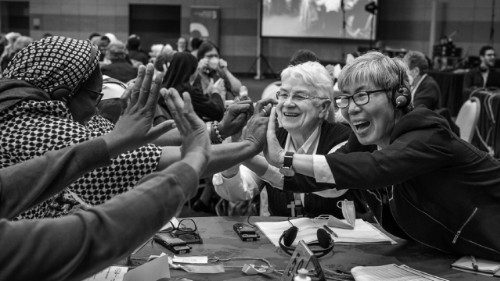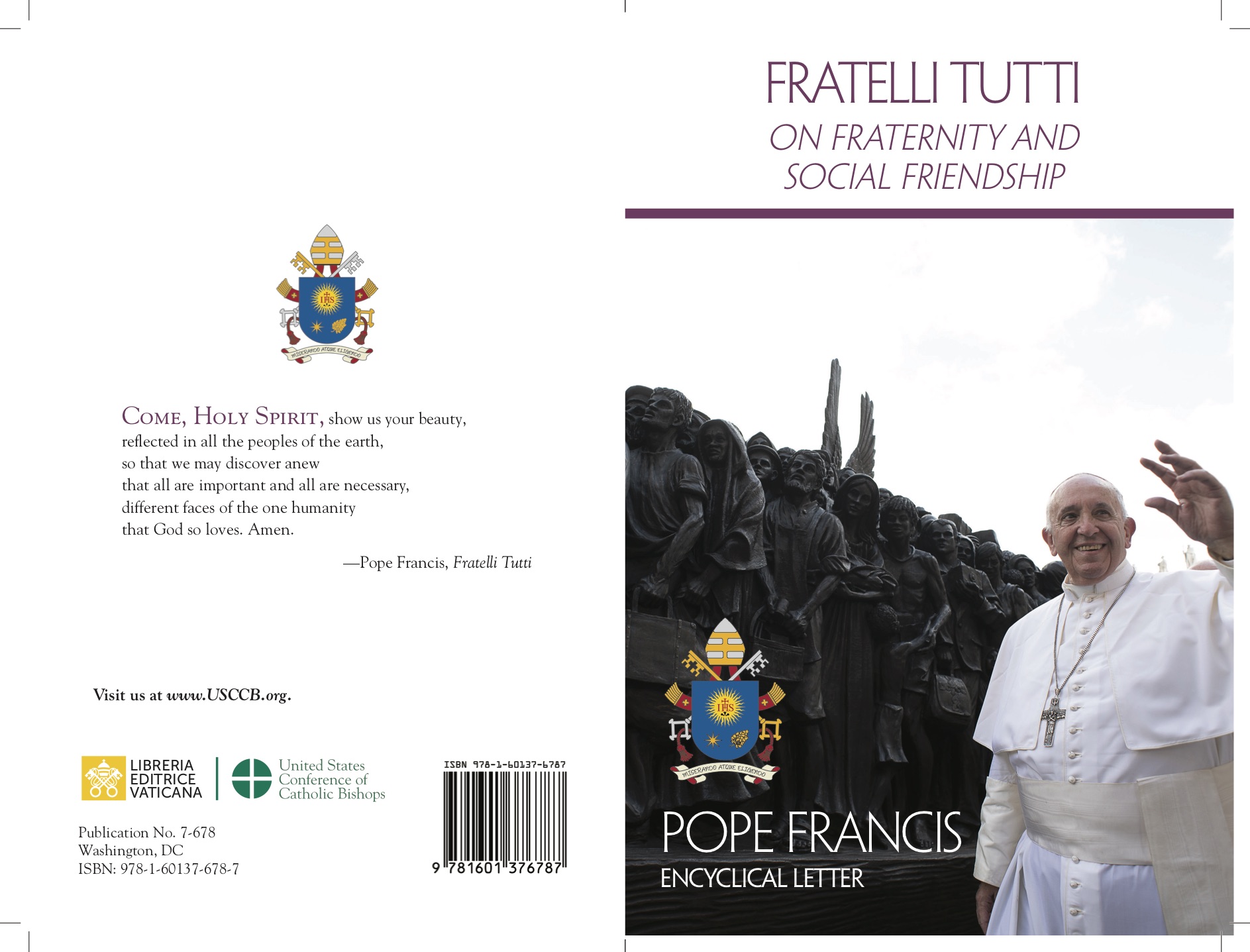
According to an Irish legend, fairies live in amongst dandelion petals, and once upon a time, before humans forced them to hide, they were free to frolic happily in the green meadows of the moors. On Sister Patricia Murray’s jacket lapel, next to a small metal cross, there is a badge with a yellow flower. She tells me, “The dandelion is the symbol of the movement created by former Irish President Mary Robinson to defend women and nature. She recently gave it to me after our meeting with the Pope. She gave one to him too”. With blue eyes behind glasses and her white hair, Sister Patricia is an energetic 77-year-old Irish woman, and the executive secretary of the International Union of Superiors General (UISG). Her curriculum tells the story of the passion and tenacity of someone who feels the urgency to not waste a single minute in the service she is performing.
Patricia Murray’s story is Irish. Her mother, a primary school teacher, and her father, a public education department employee, passed on to her the passion for civic engagement and education. “I believe that commitment to peace is in my DNA; since I was a child, I developed the awareness that peace and development are fundamental to building a better world. I experienced this firsthand growing up in my family. My parents felt they were contributing to the development of the new country, which became independent in 1920. That year, my grandfather, a policeman, was killed during the riots that shook Dublin. One of my uncles became Ireland’s ambassador to the world”. Pat, who at the age of 12 was inspired by a nun from the Beata Vergine Maria Institute (also known as the Sisters of Loreto, an Ignatian-inspired congregation), and at 18 made her profession of faith, says that she has “always deeply desired to live life as fully and meaningfully as possible”. She taught in peripheral neighborhoods, from the countryside on the borders of Northern Ireland to the poorest areas of Dublin. “And through teaching, I saw how, thanks to education, female leadership can be cultivated and supported”.
However, Sister Murray’s story is also one that passes through some of the wounds of the 20th century. She attended Trinity College and the University of Dublin during the late ‘60s, and then graduated in theology in Chicago, where she obtained her PhD in Practical Theology in 2014. She became involved in the ecumenical body engaged in peace talks between Catholics and Protestants to end the civil war in Northern Ireland. Later, from 1998 to 2006, she was in Rome as General Councilor of her Congregation. As this delicate position was coming to an end, she was asked to be part of the religious commission that visited South Sudan at the invitation of local bishops to develop a project (Solidarity with South Sudan) for a new model of mission, based on development and formation, which sees the collaboration of various religious institutes and congregations.
Finally, her’s is also an ecclesial story. 60 years ago, when the Second Vatican Council was concluding, Pat made her religious profession. As she took her first steps as a novice, the Church and women’s religious congregations were living through the urgency of the renewal called for by Vatican II. “The habit was removed, there was support and enhancement of formation, the need to work not alone but together as religious men and women”. For example, in the recent global campaign to reduce childcare in orphanages in favor of placing children in families. Sister Murray has also been called to take on responsibilities in the Vatican, as a consultant to the Dicastery for Culture and Education, and then, as the first woman in Church history, a member of the group that drafted the summary document of the last Assembly of the Synod of Bishops.
Do you consider yourself a woman of power, Sister Patricia?
I prefer to use the term “woman of influence”. And that depends on how power is viewed. There is power that oppresses, and then there is power exercised when working with others to achieve change. I believe that the UISG needs to develop partnerships and networks that can influence every level of society. I believe that every sister is called to be a spiritual influencer. We are all called to value the spiritual gifts we have to bring about change, even within our small circle.
Does the fact that you are a woman and a leader make a difference?
I believe it does, because I think as women, we are inclined to collaborate and build authentic relationships beyond divisions. That is exactly what we need today. I experienced this in South Sudan, where the students were grateful to those who taught them to become nurses, teachers, or midwives. What surprised them was that we came from “different tribes”. religious men and women, from different cultures and backgrounds. Today, to be intercultural is our testimony. It is a theological concept, meaning I change you and you change me, and together we create a new way of living where difference is respected, and where we learn and form each other.
And yet, female leadership in the Church is still struggling…
I believe it is essential that women hold leadership roles in the Church, especially because they make up more than 50% of the People of God. Where women’s contributions are missing, there is a huge deficit, because men and women bring very different ways of experiencing life. Moreover, it is not just about appointing a certain number of women to very visible roles in the Vatican.
Is there a glass ceiling for women in the Church?
It depends, first and foremost on where you live. If the bishop does not open spaces for women, then yes, there is a glass ceiling. It also depends on aspirations: some women feel called to priestly ordination, and for them, the ceiling exists. We, as sisters, carry out diaconal ministries, and some would like to see these ministries formally recognized. In general, there is a real need to redefine ministry in the Church, for which we need a much broader approach. I appreciate that Pope Francis established that women could be instituted as acolytes, lectors, or catechists; these are public ministries. In addition, I would love to see women preaching because there are wonderful women who would bring a different perspective and vision to reflect on Scripture.
What must women, both lay and religious, do to find space for an authoritative voice?
First, they need to be formed. The number of women theologians is increasing. Here at the UISG, we have a group of sister theologians who have earned doctorates. We have asked them to reflect on religious life and write from their own cultural perspectives. We need new insights and new perspectives. Because religious life was born in the global North, but now it is flourishing in the global South. What does this teach us for the future? Here at the UISG, we are working to form the leaders of congregations so they can learn to lead in a synodal way.
What is the foundation for building leadership that is not fleeting but lasting?
The foundation of leadership is a deep respect for each individual, and a recognition that the Holy Spirit is active in everyone. Then, when important decisions are made, the more consultation and reflection involved, the better the final decision will be.
When it comes to women, what changes did Pope Francis’ pontificate bring?
I believe the most important development was the affirmation of the importance of women’s roles in the Church, both in formal and informal positions, and the creation of space for greater participation at all levels. During the last synodal assembly, a long list was compiled of all the roles women could hold in the institutional Church, which are roles that are too often not even considered. There are many. When we truly desire deep change, it requires patience, because a conversion of minds and hearts is needed. And also of frameworks, in an institution that, overall, did not change much until the Second Vatican Council. However, since then, and especially in recent years, we have been witnessing significant change.
Regarding women in leadership positions, what do you think men in the Church are afraid of?
I believe they are afraid of losing power, whatever that means. The point is that during their seminary formation and later, in clerical life, priests do not interact very often with women on an equal footing. The more one shares experiences with women during personal formation, the less one fears women in leadership roles. It is a matter of life experience.
by Vittoria Prisciandaro
A Journalist for “Credere” and “Jesus”, which are San Paolo Periodicals
#sistersproject
UISG, Triennial Assembly and Sixty Years of History
The International Union of Superiors General (UISG) is celebrating an important milestone this year, which is 60 years of service to women’s consecrated life in the Catholic Church. The UISG was founded in 1965, and currently represents 1,900 superiors general who lead women’s religious congregations with over 600,000 sisters throughout the world.
The UISG was founded in the wake of the Second Vatican Council, and has responded to the challenges that have come about over these years, and become a key point of reference for Catholic women’s congregations. Today, it is presided over by Sr. Mary Barron, an Irish member of the Congregation of the Sisters of Our Lady of the Apostles. Since it was founded, the organization has promoted inter-congregational dialogue, fostered collaboration among diverse religious families, and supported joint initiatives in formation, education, and charity work.
To mark this significant anniversary, the UISG is hosting its triennial plenary assembly in Rome from May 5-9, with the theme. “Consecrated Life: A Hope that Transforms”. Around 900 superiors general from every continent are expected to attend. Presenting the assembly, President Mary Barron stated. ”Our assembly offers us the opportunity, as leaders of women’s religious congregations from around the world, to come together as Pilgrims of Hope. The testimonies of sisters who walk with their communities in situations that seem to offer no way forward will form the foundation of our reflections and our commitment to the concrete reality of today’s world”.













 Purchase the Encyclical here Fratelli Tutti
Purchase the Encyclical here Fratelli Tutti
